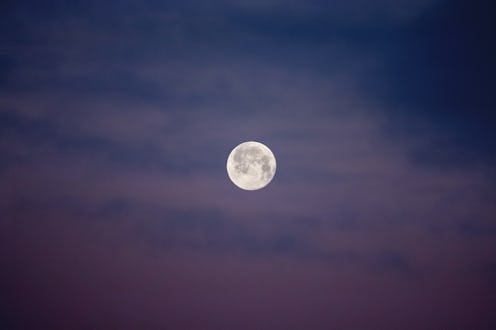Life
All The Full Moon Names & Dates For 2017

These days, most people go about their business without noticing the lunar cycle unless there's some particularly spectacular celestial event going on. In the days before desk calendars and smartphones, however, the moon was one of the best ways to keep up with the changing seasons — which means that people got creative, using full moon names to distinguish between cycles. But even if knowing that June is home to the Strawberry Moon isn't essential to our everyday survival anymore, it can still be kind of fun to keep track of the year based on each month's unique full moon.
According to Space.com, the practice of naming the full moon was common in Native American cultures, such the Creek people in the southeast to the Comanche living in the southern plains, but it wasn't exclusive to North America. Some Europeans adopted the custom when they arrived on the continent, and according to EarthSky, cultures in the Southern Hemisphere named their full moons as well. The names themselves tended to differ between peoples; today, the best-known names are those created by the Algonquin people of the northeast.
In fact, The Farmer's Almanac still lists these names each year for reference. Although the names themselves remain the same, the lunar cycle is only about 29 days long, so the exact dates of the full moon change from year to year. It can be hard to keep up with for a layperson, so here are the names and dates for each full moon in 2017.
1January: Full Wolf Moon
Date for 2017 : Jan. 12, 6:34 a.m. ET
According to the Almanac, January is also known as the Moon After Yule or the Old Moon.
2February: Full Snow Moon
Date for 2017: Feb. 10, 7:33 p.m. ET
February is one of the snowiest months, so the name is certainly appropriate. It's also known as Full Hunger Moon in some cultures.
3March: Full Worm Moon
Date for 2017: Mar. 12, 10:54 p.m. ET
As the ground finally begins to thaw, the Almanac notes that birds are able to pick at earthworms again. In more northern tribes, this moon is apparently known as Full Crow Moon or Full Sap Moon.
4April: Full Pink Moon
Date for 2017: April 11, 2:08 a.m. ET
This name refers to the explosion of one of spring's earliest-blooming wildflowers, wild ground phlox. Some coastal cultures called this moon Full Fish Moon. As Space.com points out, this moon is also the Paschal Full Moon, AKA the first full moon of spring, in 2017.
5May: Full Flower Moon
Date for 2017: May 10, 5:42 p.m. ET
This name is fairly self-explanatory. According to the Almanac, it's also known as the Milk Moon or Full Corn Planting Moon.
6June: Full Strawberry Moon
Date for 2017: Jun. 9, 9:10 a.m. ET
It's going to be hard to catch this moon, considering it's at its fullest in the middle of the morning. In Europe, this is known as the Rose Moon, but otherwise, June was universally known as the Full Strawberry Moon among Algonquin tribes.
7Full Buck Moon
Date for 2017: Jul. 9, 12:07 a.m. ET
Also known as Full Thunder Moon, this cycle is typically the time when bucks grow new antlers.
8August: Full Sturgeon Moon
Date for 2017: Aug. 7, 2:11 p.m. ET
Fishing and coastal tribes probably came up with this name, but it was also known as the Green Corn Moon and Full Red Moon in some cultures.
9September: Full Corn Moon
Date for 2017: Sept. 6, 3:03 a.m. ET
The Full Harvest Moon, the moon that occurs closest to the autumn equinox, actually changes based on year. Most of the time, it occurs in September, but every once in a while, it takes place in October. 2017 is actually one of those years, so September is known as the Full Corn Moon this year.
10October: Full Harvest Moon
Date for 2017: Oct. 5, 2:40 p.m. ET
Most of the time, October is known as the Full Hunter's Moon, but in 2017, the Harvest Moon actually takes place during this month.
11November: Full Beaver Moon
Date for 2017: Nov. 4, 1:23 a.m. ET
According to the Almanac, this was the time to set beaver traps and gather furs to stay warm in the winter.
12December: Full Cold Moon
Date for 2017: Dec. 3, 10:47 a.m.
The last lunar cycle of the year is known by several different names, including the Full Long Nights Moon and the Moon Before Yule. According to Space.com, this will be the largest full moon of the year — in other words, the only supermoon. Considering how many supermoons took place at the end of 2016, maybe it's time for a break. Otherwise, the sight of a giant full moon might lose its magic.